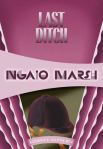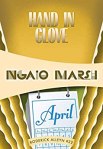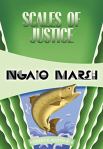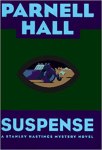 Continuing my reading of Ngaio Marsh, I found Dead Water to be more engaging than several I’ve recently reviewed. It’s unusual in that Roderick Alleyn actually has a personal interest in this case – he doesn’t just appear halfway through the book in his professional capacity. Here his longtime ago French tutor, Miss Emily Pride, seems to be in danger, and he rushes to protect her though it means interrupting his vacation with his wife Troy. This takes him to a town called Portcarrow, which is an island at high tide but connected to the mainland by a causeway during low tide – a time of “dead water.” Two years earlier, a ‘miracle’ had occurred in which a young boy named Willy Trehern had been cured of his hideous case of warts by immersing them in the water of a hillside spring; since then, many of the townspeople have benefited financially from the groups of visitors who come to the spring to rid themselves of other conditions. But Miss Pride has inherited the island and plans to put a stop to these ‘pilgrimages,’ which makes her very unpopular with some residents of Portcarrow. Indeed, there has already been at least one accident (?) that has occurred by the time Alleyn arrives.
Continuing my reading of Ngaio Marsh, I found Dead Water to be more engaging than several I’ve recently reviewed. It’s unusual in that Roderick Alleyn actually has a personal interest in this case – he doesn’t just appear halfway through the book in his professional capacity. Here his longtime ago French tutor, Miss Emily Pride, seems to be in danger, and he rushes to protect her though it means interrupting his vacation with his wife Troy. This takes him to a town called Portcarrow, which is an island at high tide but connected to the mainland by a causeway during low tide – a time of “dead water.” Two years earlier, a ‘miracle’ had occurred in which a young boy named Willy Trehern had been cured of his hideous case of warts by immersing them in the water of a hillside spring; since then, many of the townspeople have benefited financially from the groups of visitors who come to the spring to rid themselves of other conditions. But Miss Pride has inherited the island and plans to put a stop to these ‘pilgrimages,’ which makes her very unpopular with some residents of Portcarrow. Indeed, there has already been at least one accident (?) that has occurred by the time Alleyn arrives.
When a murder does occur, Alleyn is there, asking questions, checking timetables, interviewing witnesses. Eventually, he is joined by his usual sidekick, Inspector Fox, and his assistants Bailey and Thompson. There are suspects aplenty: an alcoholic landlord, his aloof but beautiful wife, a doctor, Willy’s parents, and a shopkeeper who has made a healthy profit from the tourists.
Like Roberta Gray in Death of a Peer, one of the central figures in this book, Jenny Williams, is a New Zealander living in England. But this seems arbitrary: Jenny is a former teacher of one of the characters (Willy) and the love interest of another (Patrick) and could have been from anywhere. The courtship of Jenny and Patrick is barely shown anyway. And as in Overture to Death, Marsh is very unkind in her treatment of ‘spinsters’ – who are described as sexually frustrated, petty and vindictive – though Miss Pride is, of course, an exception.
Once Alleyn has identified the murderer, there is a chase through a storm, which was meant, I assume, to be exciting but actually comes across as a little dull. Dead Water is an otherwise entertaining mystery.











